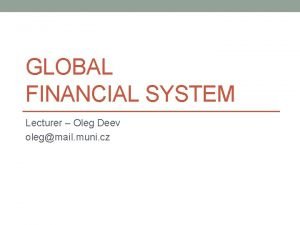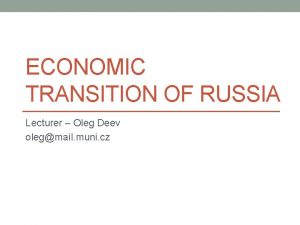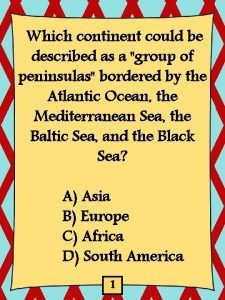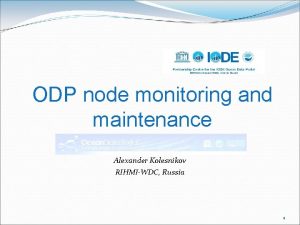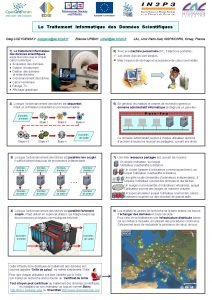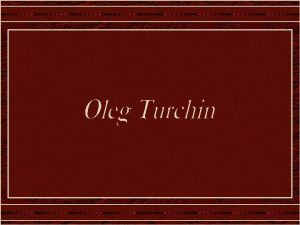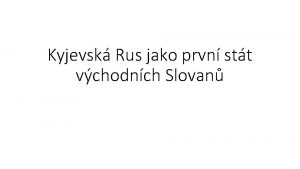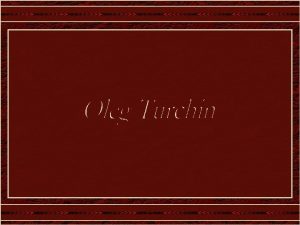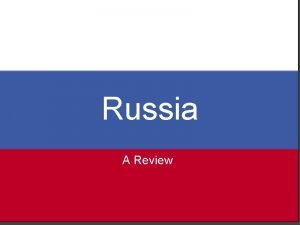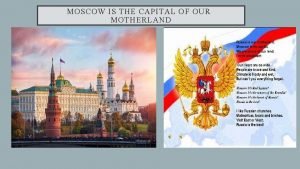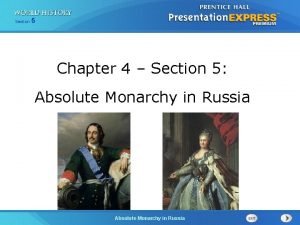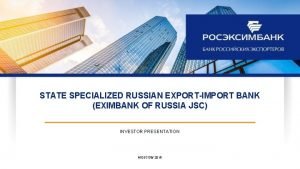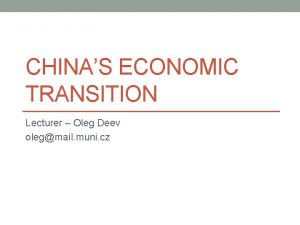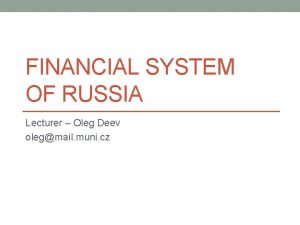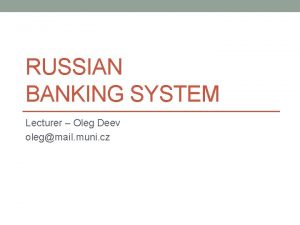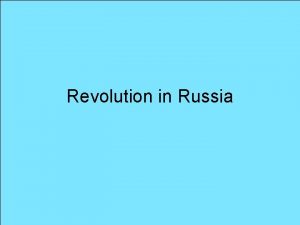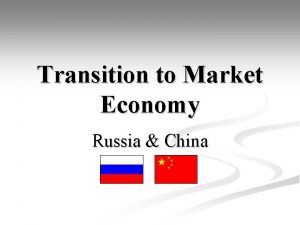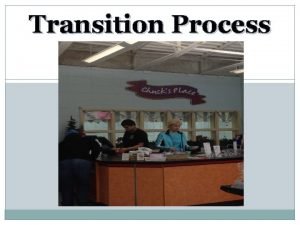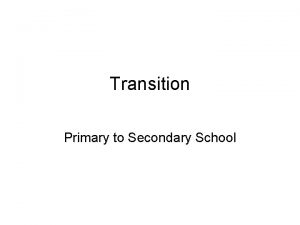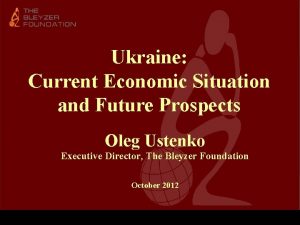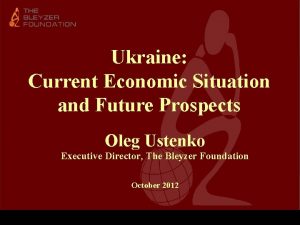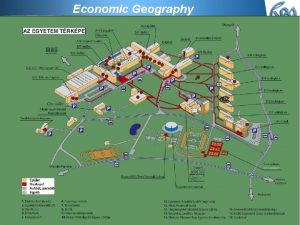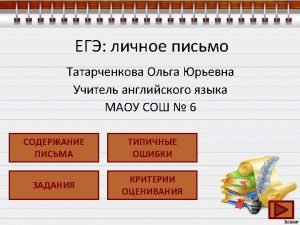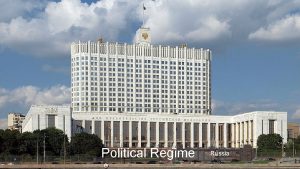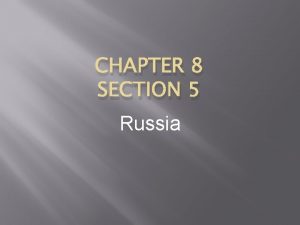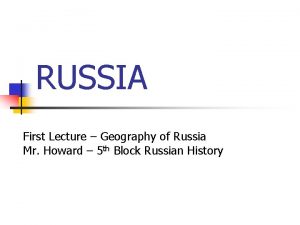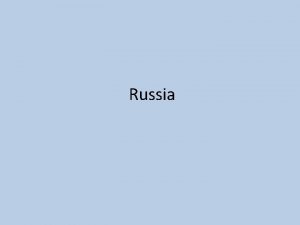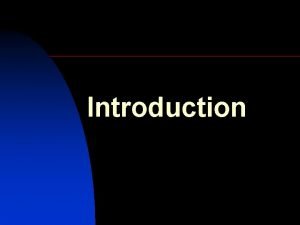ECONOMIC TRANSITION OF RUSSIA Lecturer Oleg Deev olegmail











































- Slides: 43

ECONOMIC TRANSITION OF RUSSIA Lecturer – Oleg Deev oleg@mail. muni. cz

Contents • Key factors of Russian economic development • Conditions of the transformation • Objectives and goals of the transformation • Transformation procedures • Macroeconomic situation during the transition • Results of transformation • The 1998 financial crisis • Economic growth 1999 -2008 • Russia during the global financial crisis • Challenges for the future development

John Maynard Keynes in 1925 • “The economic system of Russia has undergone such rapid changes that it is impossible to obtain a precise and accurate account of it… Almost everything one can say about the country is true and false at the same time”

Key factors of Russian economic development • The largest country in the world - 17, 075, 400 square kilomètres

Key factors of Russian economic development • The world’s largest reserves of mineral and energy resources

Key factors of Russian economic development • Conflict between the center and the periphery (diversity of population, nationality and religion) • 160 different ethnic groups and indigenous people • Religion groups – Russian Orthodox Christianity, Muslim, • • Buddhism, Catholic, Protestant, Jewish, beliefs (shamanism, pantheism, paganism, etc. ) Induction into religion takes place primarily along ethnic lines Majority of ethnic groups are settled in certain areas In modern Russia several ethnic groups have a partial sovereignty – 21 republics with its own constitution, president, and parliament within the Russian Federation The public finances are generated in the regions, transferred to the center, and only then re-allocated back to the regions

Key factors of Russian economic development • Conflict between the center and the periphery (diversity of population, nationality and religion)

Key factors of Russian economic development • Lack of investment in infrastructure • One of the world’s longest webs of railways, highways and subways • the European part is more developed than the Asian part

Key factors of Russian economic development • Vast territory • Natural resources • Conflict between the center and the periphery • Lack of investment in infrastructure • Authoritarian nature of governance to control the territory • Huge expanses on defense and military • The origins of investments are mainly internal

Starting conditions of the transition in late 1980 s - social • Low level of social inequality • as low as in Scandinavian countries • Relatively low level of corruption • Relatively low crime and mortality rates • Immense investments in the human capital • Free high-quality education in every level • One of the best education system in the world • Free health care to all citizens • Relatively high life expectancy level • Highly developed theoretical science and innovation at theoretical level

Starting conditions of the transition in late 1980 s - economic • Centralized bureaucratic allocation replaced market allocation • Economic policy making was strictly hierarchical • Macroeconomic situation – closed economy with the volume of • • money exceeded the volume of goods; Microeconomic situation – people demanded other goods than those supplied No initiative behavior among people and enterprises Economic distortion of prices Structural dysfunction of the economy (with prevailing heavyindustries enterprises) Budget deficit – more than 6% of GDP Excessive foreign debt – 30 to 40% of GNP Falling oil prices Economic growth – 1 to 3%

USSR economic experiments of systematic changes • 1920 s – NEP – New Economic Policy • 1930 s – Industrialization & Collective farming • 1950 s – Khrushchev’s reforms • 1960 s – Brezhnev’s reforms • 1980 s – Gorbachev’s reforms – transition to indicative planning; introduction of some market mechanisms – leased enterprises, family farming, joint ventures with foreign capital • ended up with political democratization • Reforms did not change the planned nature of the economy

Objectives • Restructuring of the national economy • Macroeconomic stabilization Goals • Deregulation and promotion of competition • Prices and interest rates liberalization (if to let go the prices, the output might be saved) • Liberal foreign trade police (open market) • Establishment of property rights • Development of the market economy institutions

Starting the transition Boris Yeltsin Yegor Gaidar

Price liberalization – early 1992 Average monthly growth rates of money supply (M 3), prices and industrial output by quarters, % 30. 0 6. 0 25. 0 3. 0 20. 0 15. 0 -3. 0 10. 0 -6. 0 M 3 (left scale) Prices (left scale)* *Lagged 4 months. 4 Q 1994 3 Q 1994 2 Q 1994 1 Q 1994 4 Q 1993 3 Q 1993 2 Q 1993 1 Q 1993 4 Q 1992 3 Q 1992 2 Q 1992 -9. 0 1 Q 1992 5. 0

External liberalization - 1992 Russia's foreign trade, billion $ 100 90 80 Trade surplus Export 70 60 50 Import 40 30 20 1993 1994 1995 1996 1997 1998

Privatization – since 1988 • Spontaneous privatization (1988 -1991) • control over some industrial assets was acquired by their managers • this accounted for only several thousand enterprises, a small part of the Soviet industry • Voucher privatization (1992 - 1994) • each voucher were corresponding to a share in the national wealth • vouchers were distributed equally among the population, including minors • vouchers could be exchanged for shares in the enterprises to be privatized • low price of vouchers $7 -10 – less than an average monthly wage • most shares were acquired by the management of the enterprises

Privatization – since 1988 • Loans for shares (1995) • included most oil, gas and other natural resource-based companies, which were highly profitable ones and were supposed to be sold for cash • industrial assets were leased through auctions for money lent by commercial banks to the government • the auctions lacked competition, as they were largely controlled by favored insiders • scheme that gave rise to the class of Russian business oligarchs, who have concentrated enormous assets • banks and enterprises involved in the scheme stopped seeing an interest in maintaining high inflation

Macroeconomic instability Annual inflation rates in Russia (December-to-December increase in CPI, log scale) 10000 2510 100 10 1991 1992 1993 1994 1995 1996 1997 1998 1999 2000 2001 2002 2003 2004 2005

Anti-inflation policy – 1992 -1998 • First half of 1992 (Gaidar). Growth of money supply was restricted; inflation fell to 10% a month in summer 1992; as a consequence, massive non-payments emerged • First half of 1994 (Chernomyrdin). Tightened monetary policy allowed to bring down inflation to 5% a month in summer 1994; again, non-payments increased • mid 1995: exchange rate based stabilization; inflation brought down to 6% a year (July 1998 to July 1997); currency crisis in August 1998, acceleration of inflation

Why high inflation was so persistent? • There was no consensus among major lobbying groups, how to finance reforms, therefore it was impossible to balance the budget • Problems with tax collection: high level of tax evasion in the 1990 s. The government was willing, but not able to increase tax revenues • Attempts to tighten monetary policy caused non-payments

What was expected? GNP growth rates, % 0. 15 0. 1 0. 05 Government 0 -0. 05 -0. 15 -0. 25 -0. 3 1985 1987 1989 1991 1993 1995 CIA Government, May 1990, shock therapy Government, May 1990, gradual reform Gosplan, March 1991 Pavlov, April 1991, if no measures are taken

Results (1991 -1998) • Free market • Private business – 70% of GDP • Huge fall in output • High inflation • Income redistribution • Privatization – controversial results • people’s disapproval & emergence of oligarchs • Organized crime and corruption • Capital flight – $20 billion a year • The development of barter economic relations and dollarization • Unemployment and poverty • Deterioration of education system, health care, demographics • Inadequate pension system • Inefficient legal system • Existence of shadow economy

GDP growth rates, % 10 5 0 -5 -10 -15 1990 1991 1992 1993 1994 1995 1996 1997 1998 1999 2000 2001 2002 2003 2004

Personal incomes - % of level in 1991

Human development

Human development

Human development

Russian financial crisis – August 1998 Consolidated government revenues and expenditure, % of GDP 70 60 50 40 30 20 1992 1993 1994 1995 Expenditures 1996 Revenues 1997 1998

Russian financial crisis – August 1998 Budget Deficit, % of GDP 20 18 16 14 12 10 8 6 4 2 0 1992 1993 1994 1995 1996 1997 1998 1999 2000

Russian financial crisis – August 1998 Government debt, % of GDP 70 60 50 40 External debt 30 20 10 Short-term debt held by CBR credits to the government Short-term debt (GKO-OFZ) held by the banks 0 1994 1995 1996 1997 July 1, 1998

Russian financial crisis – August 1998 • 1997 - Inflow of portfolio investment of $46 billion or 10% of GDP • High volatility of exchange rate – ruble/USD (high valuation of ruble) • Extremely high interest rates • 1998 – world price for Russia’s oil – 10$ per barrel • The government was not able to refinance it’s debt

Measures – August 1998 • Devaluation of the ruble • At the moment the ruble/dollar trading band was expand from 5. 3 -7. 1 RUR/USD to 6. 0 -9. 5 RUR/USD • Later the RUR/USD rate was set to move freely within the wider band • Default on domestic debt • To prevent mass Russian bank default Russia's rubledenominated debt would be restructured • A moratorium on payment to foreign creditors • A temporary 90 -day moratorium was imposed on the payment of some bank obligations, including certain debts and forward currency contracts

Russia's 1998 financial collapse • In a matter of days the exchange rate lost over 60% of its value • more than in all most Latin American and Southeast Asian countries (except for Indonesia) • Prices increased by nearly 50% in only 2 months after the crisis • as compared to less than 6% annual inflation July 1998 to July 1997 before the crisis • Real output fell by about 6% in 1998 • after registering a small increase of 0. 6% in 1997 for the first time since 1989, it fell in January - September 1998, i. e. mostly before the August 1998 crisis

Why was the drop so drastic? • Some of the standard explanations • Bad institutions • Natural resource dependence • Bad policies • For a medium income level country, Russia is trade wise open • Financial dependence proved important • Short-term debt was concentrated and fast growing • Dependence of financial intermediation on foreign funding • The dual financial system: households and most companies using domestic markets; some big companies and banks dependent on foreign markets

Measures 1998 -1999 • Budget reform • Expenditures and arrears reduction • Revision of expenditures • Taxation reform • The creation of efficient taxation system • Changes in banking sector • The worst half of the banks was closed • Strengthening the governance of banks • The payment system improvement

So why the talk of a safe haven? • Politicians were not in the business of doom-saying • Shifting blame to where it belonged: global imbalances • Good grounds why a pure financial crisis might handle Russia softly • Small financial sector with limeted role in investment finance • Strong public sector financial position – taxation reform • Households with no financial wealth, little debt: no wealth effect on consumption • Labor markets expected to be very flexible

After the crisis • Boom in industry • After devaluation, domestic producers were taking advantage of new export opportunities and made shift from foreign to Russian made goods • Devaluation of the previously overvalued currency restored the previously lost competitiveness • Output was falling in the beginning of 1998, but started to grow in October (unlike in East Asia, where output fell after the currency crises)

Economic growth – 1999 -2008

Output is growing, inflation is under control

Oil price grows, GDP does not accelerate Oil prices ($ per barrel, right scale) and GDP growth rates (%, left scale) 15 70 Oil price 60 10 GDP growth rates 50 5 40 0 30 -5 20 2007 2006 2005 2004 2003 2002 2001 2000 1999 1998 1997 1996 1995 1994 1993 0 1992 -15 1991 10 1990 -10

Russia’s anti-crisis policies – 2008 -2009 • Basically similar to those in other countries • Package of tax reforms, reducing the tax burden • Emphasis on monotowns, pensions, minimum wages - crisis fighting as a social policy measure • Since 2005 - emphasis on social policy, with view on demography (national priority programs). In practice - expenditure on health, education and housing are stable as share of budget, increasing in line with total expenditure • Since 2007 - decisions to increase pensions, minimum wages, public sector salaries were made • Structure of the banking system left no alternative to ”favoring” state-controlled banks as liquidity channels

Challenges for the future • Unpredictable export revenue • Oil price • Energy efficiency needed for maintaining export volumes • Changes in gas markets • Regaining budget surplus • Re-accumulating reserve funds is a high priority • Expenditure pressure due to recent hikes, long-term needs • Revenue problem due to declining share of energy sector in GDP • Exchange rate policy • Increased flexibility of nominal rate, no pure inflation targeting • Real exchange rate appreciation pressures as financial inflow resumes • Financial system development • Rolling back the state • Need for long-term domestic funding • Pension reform • Increasing dependency ratio • Previous failures to depart from pay-as-you-go • Competitiveness of jobs
 Oleg deev
Oleg deev Oleg deev
Oleg deev Lecturer's name or lecturer name
Lecturer's name or lecturer name The geographic feature most responsible for extensive trade
The geographic feature most responsible for extensive trade Lector vs lecturer
Lector vs lecturer Spe distinguished lecturer
Spe distinguished lecturer Photography lecturer
Photography lecturer Why himalayan rivers are pernnial in nature
Why himalayan rivers are pernnial in nature Jeannie watkins
Jeannie watkins Lecturer in charge
Lecturer in charge Lecturer in charge
Lecturer in charge Lecturer name
Lecturer name Spe distinguished lecturer
Spe distinguished lecturer Cfa lecturer handbook
Cfa lecturer handbook Designation lecturer
Designation lecturer Pearson lecturer resources
Pearson lecturer resources Good afternoon teacher
Good afternoon teacher Lecturer asad ali
Lecturer asad ali Designation of lecturer
Designation of lecturer Oleg kolesnikov
Oleg kolesnikov Oleg kouznetsov
Oleg kouznetsov Oleg figovsky
Oleg figovsky Oleg kolesnikov
Oleg kolesnikov Oleg grachov
Oleg grachov Oleg lodygensky
Oleg lodygensky Moldvia
Moldvia Kyjevska rus mapa
Kyjevska rus mapa Oleg shuplyak biography
Oleg shuplyak biography Oleg turchin
Oleg turchin Oleg kouznetsov
Oleg kouznetsov Oleg shuplyak freud voyeur
Oleg shuplyak freud voyeur Oleg zhivetin
Oleg zhivetin Diode works on the principle of electroluminescence
Diode works on the principle of electroluminescence Oleg rokhlenko
Oleg rokhlenko Emenim rap
Emenim rap Growth and development conclusion
Growth and development conclusion Chapter 1 lesson 2 our economic choices worksheet answers
Chapter 1 lesson 2 our economic choices worksheet answers Economic growth vs economic development
Economic growth vs economic development Levels of government in russia
Levels of government in russia Seven in russian
Seven in russian Stalin tower
Stalin tower Absolute monarchy in russia
Absolute monarchy in russia There was a man from russia long ago
There was a man from russia long ago Eximbank of russia
Eximbank of russia
